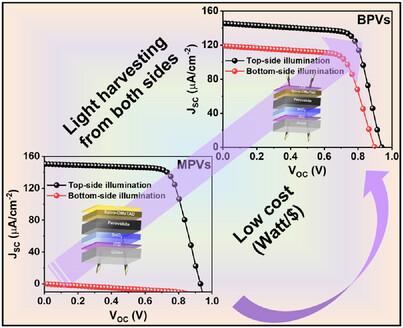Modeling and Performance Analysis of Indoor Bifacial Perovskite Photovoltaics with SCAPS-1D
IF 2.9
4区 工程技术
Q1 MULTIDISCIPLINARY SCIENCES
引用次数: 0
Abstract
Indoor bifacial photovoltaics (i-BPVs) have drawn a lot of interest as a possible option for efficiently absorbing light from artificial indoor light sources. Comparing other emerging PV technologies, perovskite-based i-BPVs (i-BPPVs) have shown superior device performance under artificial light sources with affordable fabrication cost. Nonetheless, designing i-BPPVs to efficiently harvest energy from indoor light sources remains both challenging and attractive research field. This study mainly focuses on the simulation of i-BPPVs, aiming to optimize their performance under various ideal and non-ideal conditions using SCAPS-1D. The effects of various parameters such as series and shunt resistance, perovskite layer thickness, interfacial defects, irradiance power, and temperature are investigated under indoor light environments. Designed bifacial architecture Glass/ITO/SnO2/MAFAPbI3/Spiro-OMeTAD/ITO have shown power conversion efficiencies (PCE) of 33.74% and 23.45%, when exposed from top- and bottom-sides, respectively, employing nearly realistic operating conditions. The outcomes of this simulation study provide crucial insights into the design and development of next-generation i-BPPVs, opening the door to more efficient and sustainable indoor energy harvesting options.

基于SCAPS-1D的室内双表面钙钛矿光伏电池建模与性能分析
室内双面光伏(i- bpv)作为一种有效吸收室内人造光源的可能选择,引起了人们的广泛关注。与其他新兴光伏技术相比,基于钙钛矿的i-BPPVs (i-BPPVs)在人工光源下表现出优越的器件性能,且制造成本可承受。尽管如此,设计i- bppv以有效地从室内光源中收集能量仍然是一个具有挑战性和吸引力的研究领域。本研究主要对i- bppv进行仿真,利用SCAPS-1D优化其在各种理想和非理想条件下的性能。在室内光环境下,研究了串联和并联电阻、钙钛矿层厚度、界面缺陷、辐照功率和温度等参数对复合材料的影响。设计的双面结构玻璃/ITO/SnO2/MAFAPbI3/Spiro-OMeTAD/ITO在接近实际的工作条件下,从顶部和底部分别暴露时,功率转换效率(PCE)分别为33.74%和23.45%。这项模拟研究的结果为下一代i- bppv的设计和开发提供了重要的见解,为更高效和可持续的室内能量收集选择打开了大门。
本文章由计算机程序翻译,如有差异,请以英文原文为准。
求助全文
约1分钟内获得全文
求助全文
来源期刊

Advanced Theory and Simulations
Multidisciplinary-Multidisciplinary
CiteScore
5.50
自引率
3.00%
发文量
221
期刊介绍:
Advanced Theory and Simulations is an interdisciplinary, international, English-language journal that publishes high-quality scientific results focusing on the development and application of theoretical methods, modeling and simulation approaches in all natural science and medicine areas, including:
materials, chemistry, condensed matter physics
engineering, energy
life science, biology, medicine
atmospheric/environmental science, climate science
planetary science, astronomy, cosmology
method development, numerical methods, statistics
 求助内容:
求助内容: 应助结果提醒方式:
应助结果提醒方式:


